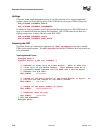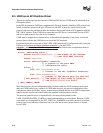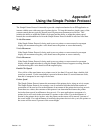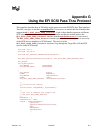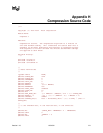
Version 1.10 12/01/02 F-1
Appendix F
Using the Simple Pointer Protocol
The Simple Pointer Protocol is intended to provide a simple mechanism for an EFI application to
interact with the user with some type of pointer device. To keep this interface simple, many of the
custom controls that are typically present in an OS-present environment were left out. This
includes the ability to adjust the double-click speed and the ability to adjust the pointer speed.
Instead, the recommendations for how the Simple Pointer Protocol should be used are listed here.
X-Axis Movement:
If the Simple Pointer Protocol is being used to move a pointer or cursor around on an output
display, the movement along the x-axis should move the pointer or cursor horizontally.
Y-Axis Movement:
If the Simple Pointer Protocol is being used to move a pointer or cursor around on an output
display, the movement along the y-axis should move the pointer or cursor vertically.
Z-Axis Movement:
If the Simple Pointer Protocol is being used to move a pointer or cursor around on an output
display, and the application that is using the Simple Pointer Protocol supports scrolling, then the
movement along the z-axis should scroll the output display.
Double Click Speed:
If two clicks of the same button on a pointer occur in less than 0.5 seconds, then a double-click
event has occurred. If a the same button is pressed with more than 0.5 seconds between clicks,
then this is interpreted as two single-click events.
Pointer Speed:
The Simple Pointer Protocol returns the movement of the pointer device along an axis in counts.
The Simple Pointer Protocol also contains a set of resolution fields that define the number of
counts that will be received for each millimeter of movement of the pointer device along an axis.
From these two values, the consumer of this protocol can determine the distance the pointer
device has been moved in millimeters along an axis. For most applications, movement of a
pointer device will result in the movement of a pointer on the screen. For each millimeter of
motion by the pointer device in the x-axis, the pointer on the screen will be moved 2 percent of
the screen width. For each millimeter of motion by the pointer device in the y-axis, the pointer on
the screen will be moved 2 percent of the screen height.




